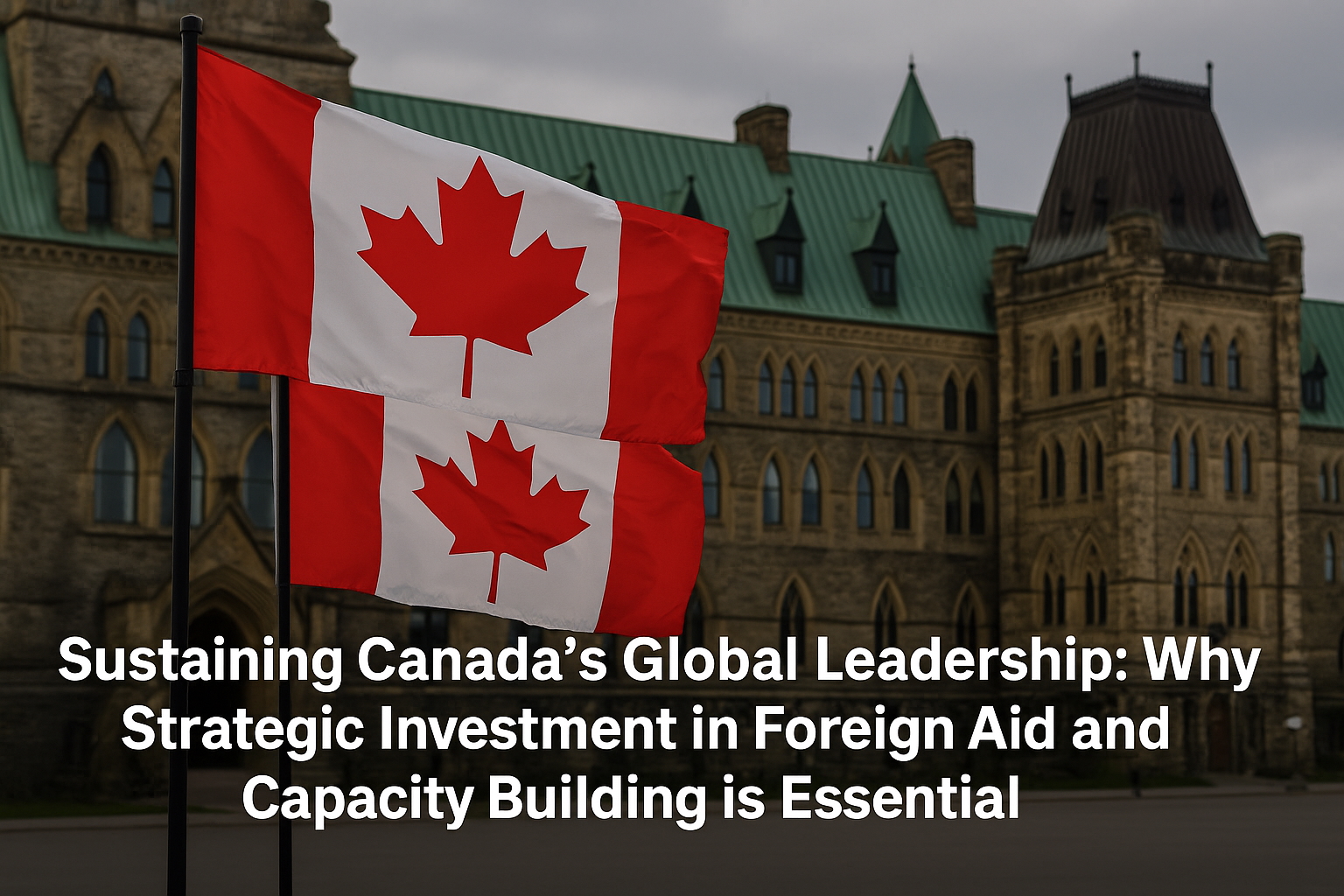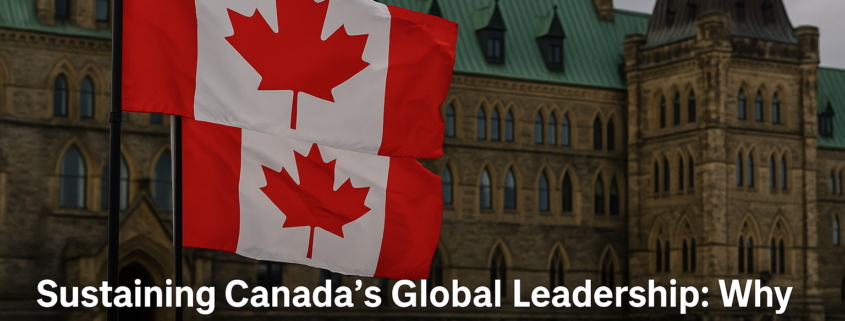Canada’s Silent Strength: Foreign Aid as a Security Strategy

Canada’s foreign aid and capacity building efforts are a cornerstone of its international credibility and strategic security.
Canada’s reputation as a reliable global partner—and its own national security—depends on continued investment in foreign aid, diplomacy, and international capacity building programs. Here’s why scaling back is strategically short-sighted.
Introduction
In an era defined by rising instability, global interdependence, and shifting geopolitical alliances, Canada’s strategic influence on the world stage is not merely shaped by its military or economic strength, but by the trust it cultivates through diplomacy, development, and international cooperation.
Investments in Global Affairs Canada (GAC) initiatives, foreign aid, and capacity building programs are essential to this trust. These tools serve both Canada’s ethical commitments and its strategic interests—strengthening global partnerships, preventing crises before they escalate, and projecting Canada’s values through smart power.
Yet these initiatives are increasingly targeted during political cycles as easy cost-saving measures. The reality is, however, that cutting these programs weakens Canada’s long-term resilience, security, and global standing.
The Strategic Value of Foreign Aid and Global Affairs Programs
Building Canada’s Brand as a Trusted Security Partner
Canada’s contributions to global peace, stability, and development serve as reputational assets that reinforce its credibility as a partner in diplomacy, security cooperation, and economic development.
Key strategic benefits include:
- Strengthened multilateral ties with allies and international institutions.
- Greater influence in global security coalitions and development frameworks.
- Enhanced positioning for Canadian companies in foreign markets with Canadian development presence.
- A durable soft power advantage that makes Canada a preferred partner, mediator, and peacebuilder.
When nations witness Canadian-funded projects improving lives or stabilizing regions—from clean water initiatives to policing reforms—they associate Canada with integrity, competence, and commitment. This perception directly affects Canada’s ability to negotiate trade deals, security pacts, and joint development agreements.
Notable GAC Programs and Their Impact
Canada has long invested in critical global initiatives through GAC, including:
- Peace and Stabilization Operations Program (PSOPs): Supports fragile and conflict-affected states through deployments, training, and crisis response.
- Canada Fund for Local Initiatives (CFLI): Empowers civil society and grassroots organizations to promote human rights, democratic governance, and local resilience.
- Anti-Crime Capacity Building Program (ACCBP) and Counter-Terrorism Capacity Building Program (CTCBP): Help partner countries disrupt transnational threats.
- Development Assistance Programs: Focus on gender equality, education, healthcare, and climate adaptation in the Global South.
These programs not only support global stability but reduce the burden on Canadian resources in responding to humanitarian disasters, pandemics, and irregular migration.
Source: Global Affairs Canada – Development Funding
Capacity Building as a First Line of Defense
Preventing Problems Before They Reach Canadian Shores
From maritime piracy to irregular migration to transnational organized crime, many of today’s challenges do not respect borders. Canada’s strategy must include supporting other nations’ ability to manage their own security and governance challenges.
Capacity building works by:
- Supporting border management and maritime security in regions prone to trafficking or piracy.
- Developing early warning systems and crisis response mechanisms.
- Providing training and infrastructure support for civilian and security institutions.
These proactive approaches offer significantly higher return on investment than waiting for crises to arrive.
For instance, assisting Caribbean or West African states to interdict narcotics shipments or combat IUU fishing upstream helps protect Canadian ports and ecosystems without requiring domestic enforcement escalation.
The Cost of Disengagement: Why Pulling Back Is Short-Sighted
While reducing foreign aid or scaling back global programs may offer immediate political appeal, the long-term costs are severe:
- Strategic voids are quickly filled by rivals such as China or Russia, undermining Western alignment and influence.
- Crises escalate in the absence of early intervention, leading to more expensive humanitarian responses and resettlement needs.
- Lost economic opportunities arise when Canadian businesses no longer benefit from stable markets supported by Canadian aid.
- Global credibility declines, reducing Canada’s ability to convene or lead on multilateral issues like climate action, global health, or cyber norms.
These choices often represent political optics over policy rationale. The actual fiscal savings are marginal, while the strategic and reputational losses are significant and enduring.
A Whole-of-Government Advantage
Foreign aid and GAC programming are part of a broader ecosystem of Canadian international engagement, including:
- Canadian Armed Forces (CAF): Through NATO missions, disaster relief, and international training.
- Canada Border Services Agency (CBSA): Providing training and systems to partner customs agencies.
- Royal Canadian Mounted Police (RCMP): Deployed in international peacekeeping and capacity development.
- Department of Fisheries and Oceans (DFO): Engaging in international oceans management and enforcement partnerships.
This multi-departmental alignment increases the impact of every dollar spent and amplifies Canada’s whole-of-government coordination capacity.
Summary Table: Strategic Rationale for Foreign Aid and Capacity Building
|
Category |
Strategic Benefit |
Long-Term Value |
Cost of Withdrawal |
|---|---|---|---|
|
Global Affairs Aid Programs |
Diplomatic trust, policy influence, partner stability |
Greater global leverage, trade readiness |
Loss of reputation, aid dependency rises |
|
Capacity Building & Training |
Crisis prevention, local empowerment |
Reduced global threats, sustainable partnerships |
Increased crises at borders |
|
Whole-of-Government Coordination |
Amplified impact, efficient international presence |
Cohesive global engagement, interoperability |
Fragmented, reactive foreign policy |
|
Brand & Soft Power |
Reliable partner perception |
Global leadership, conflict mediation roles |
Ceding influence to rivals (China, Russia) |
Tips & Takeaways
- Think of aid as a national security tool, not charity.
- Support for fragile states reduces the need for crisis response.
- Aid buys influence in ways military presence cannot.
- Pullbacks may save little, but cost Canada dearly in the long run.
- Smart power strengthens both Canada’s global voice and domestic safety.
Tools & Resources
Future Outlook
As global instability grows—from climate disruptions to geopolitical rivalries—Canada’s strategic positioning will depend more on global partnerships than ever before. Cutting investment now would be a retreat from the very spaces where Canadian values, trade interests, and security are at stake. Maintaining—and smartly evolving—Canada’s foreign aid and capacity-building posture is not just a moral imperative, but a strategic necessity for the next decade and beyond.
Note: This article was created with the assistance of generative AI, based on verified knowledge and content frameworks. It is subject to updates as new information becomes available.

 © 2025 Spheira Media. All rights reserved. Licensed for editorial use in association with articles on Canadian foreign policy and international development.
© 2025 Spheira Media. All rights reserved. Licensed for editorial use in association with articles on Canadian foreign policy and international development.